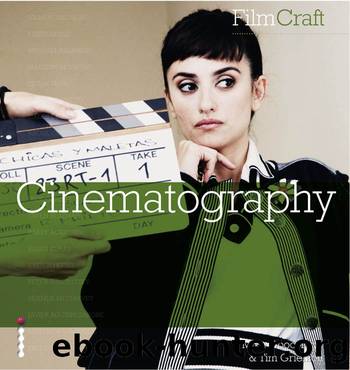FilmCraft Cinematography by Mike Goodridge

Author:Mike Goodridge
Language: eng
Format: epub
Publisher: Ilex Press/ Ivy Press
Published: 2011-08-14T16:00:00+00:00
COLLATERAL
Beebe worked twice with exacting director Michael Mann—first on Collateral and then on Miami Vice. The film was shot on the VIPER camera. “Working in the digital format for the first time was an amazing experience because you could line up a camera on the streets of LA at night and see buildings silhouetted against the night sky. You couldn’t do that on film at that time. The big challenge is that you are almost working backward with a camera that sensitive. You set up your camera to capture as much of the background as possible and then you start bringing in your actors and it has to feel completely seamless and unlit, yet it has to be lit. Traditional lighting didn’t work. Any sort of backlight or hard key just felt fake and, of all the tools in a cinematographer’s chest, knowing when something feels wrong is your biggest asset. So we worked with ultra, ultra soft lighting fixtures in order to light faces. For the first time, my meter was useless. We were working at levels where my light meter couldn’t register a single dot. It became about studying it, trying to match colors to the streetlights, finding a way of making it seamless, and making it feel like the environment was lighting the actors. When your environment is almost entirely self-lit, you’ve got to work harder and more subtly to illuminate your actors.”
In the taxi cab sequences, paper-thin photo-luminescent panels were rigged throughout the car. “Getting into that cab and working with this rather odd light source was a quick education,” he says. Perhaps the film’s most celebrated scene is when a coyote strides quietly across a street in full glare of Jamie Foxx’s taxi cab. “Doing that scene was sheer madness,” recalls Beebe. “We shot earlier dialogue sequences with Tom and Jamie and then rushed off down Olympic Boulevard to get into place because it was 3 or 4 in the morning and we were holding up traffic. We had animal wranglers there, and cameras in the middle of the road, but when you release a coyote onto the streets you don’t really know what it’s going to do.
“The camera was in the hand but they are never locked off because Michael likes to capture a moment of unease. He feels handheld is imperceptible unless you are chasing someone, but you do feel the energy of the operator in the frame lines. So we had two cameras in the hand, and it was a crazy moment, but for me it is the defining moment of that film, and that’s what Michael brings to a script. He can visually define the movie in one image. That scene says everything. And that’s the thing, it’s those moments in a film where everything seems to connect and line up.”
Download
This site does not store any files on its server. We only index and link to content provided by other sites. Please contact the content providers to delete copyright contents if any and email us, we'll remove relevant links or contents immediately.
Shoot Sexy by Ryan Armbrust(17142)
Portrait Mastery in Black & White: Learn the Signature Style of a Legendary Photographer by Tim Kelly(16484)
Adobe Camera Raw For Digital Photographers Only by Rob Sheppard(16387)
Photographically Speaking: A Deeper Look at Creating Stronger Images (Eva Spring's Library) by David duChemin(16161)
Bombshells: Glamour Girls of a Lifetime by Sullivan Steve(13108)
Art Nude Photography Explained: How to Photograph and Understand Great Art Nude Images by Simon Walden(12348)
Perfect Rhythm by Jae(4621)
Pillow Thoughts by Courtney Peppernell(3397)
The Book of Joy by Dalai Lama(3217)
Good by S. Walden(2915)
The Pixar Touch by David A. Price(2739)
Fantastic Beasts: The Crimes of Grindelwald by J. K. Rowling(2543)
A Dictionary of Sociology by Unknown(2518)
Humans of New York by Brandon Stanton(2379)
Read This If You Want to Take Great Photographs by Carroll Henry(2303)
Stacked Decks by The Rotenberg Collection(2270)
On Photography by Susan Sontag(2130)
Photographic Guide to the Birds of Indonesia by Strange Morten;(2088)
Insomniac City by Bill Hayes(2084)
